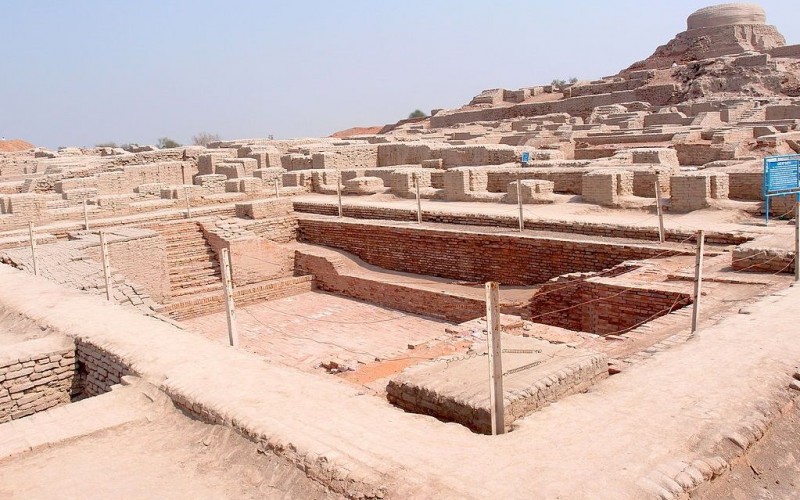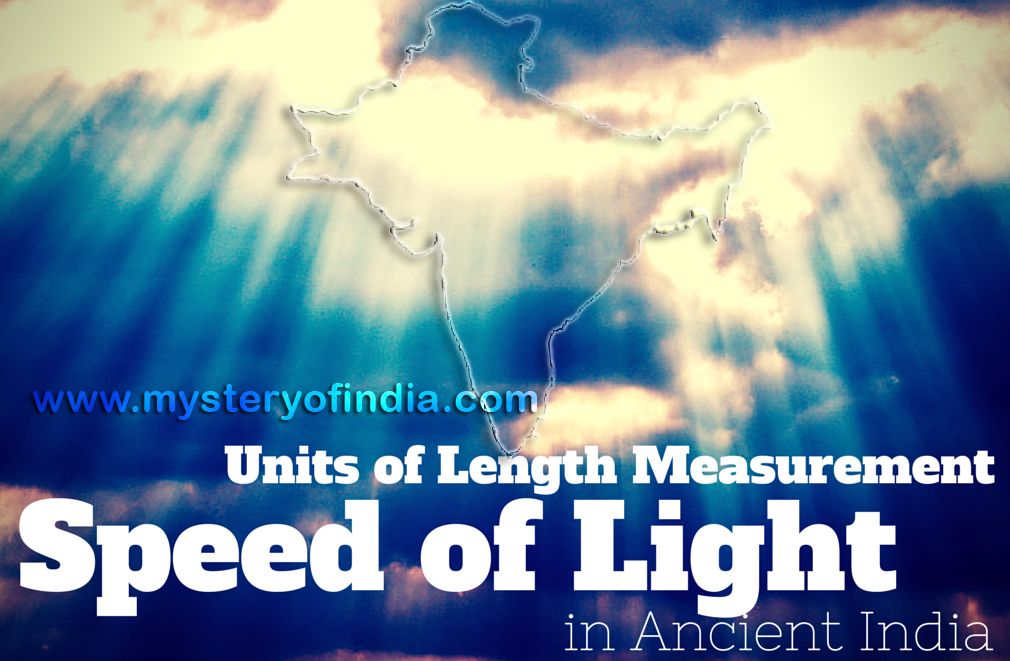An exact value of the unit of length measurement, used in Indus Saraswati Civilization, has been determined from the precise scale discovered by Ernest Mackay in the 1930-31 season excavation at Mohenjo-daro, and further correlated with the present day units of measurement. It has then been calculated and shown that the speed of light as given in the Vedic literature, when referenced with this erstwhile unit of length measurement (used in Indus-Saraswati Civilization), works out to be precisely equal to the speed of light as per modern measurements. The present article is a step-wise process followed to unveil this equality.
The Precise Scale
In his 1930-31 season at Mohenjo-daro, Ernest Mackay discovered a broken piece of shell bearing 8 divisions of 6.7056mm each, with a dot and circle five graduations apart, which suggests a decimal system. However, attempts by Mackay, to relate such a unit to the dimensions in Mohenjo-daro, were not very successful and thus were abandoned.
Units of Length in Chanakya’s Arthashastra
Chanakya was the political mentor of the legendary Indian monarch Chandragupta Maurya of 4th century BC. He was a man learned in many disciplines and wrote the famous book Arthashastra. In Arthashastra, Chanakya mentions two types of Dhanushas as units for measuring lengths and distances. One is the ordinary Dhanusha, consisting of 96 Angulas, and the other Dhanusha is mentioned as Garhpatya Dhanusha and consists of 108 Angulas, used for measurement of roads and distances. Chanakya also mentions that a Dhanurgraha consists of 4 Angulas and a Yojana consists of 8000 Dhanushas.
Decoding the Mohenjo-daro Scale
If we keep 10 divisions of the Mohenjo-daro scale to be equal to a Dhanurgraha or 4 Angulas, the precise length of an Angula works out to be 16.764mm.
|
|
|
|
|
Interestingly, when we look into the history of mile, we find that the word mile is derived from mille, which means a thousand.
Other Ancient Scales
The Indus Inch
The Indus civilisation unit of length, widely known as Indus Inch was 1.32 Inches which is exactly equal to 2 Angulas of 16.764mm each.
The Gudea’s Rule
The Gudea’s rule (2175 B.C.) preserved in the Louvre shows intervals in Sumerian Shusi of 0.66 inches, which is exactly equal to the Indus-Saraswati Angula of 16.764mm.
Temple Wall-Engravings
Two engravings on a wall of the temple at Tiruputtkali (12th Century A.D.) near Kanchipuram, show two scales one measuring 7.24 metres in length, with markings dividing the scale into 4 equal parts, and the second one measuring 5.69 metres in length and markings dividing the scale into 4 equal parts. It may be observed that each division of the first scale is precisely equal to a Dhanusha of 108 Angulas of 16.764mm each. Interestingly, the second scale is precisely equal to 71 times Dhanusha i.e. equal to the circumference of a circle with one Dhanusha as its Diameter.
It is interesting to note here that Mackay reports at Mohenjo-daro, a lane and a doorway having both a width of 1.42m, which is precisely equal to one division of the second scale at the Tiruputtkali Temple, indicating that both the scales were prevalent in Indus-Saraswati Civilization as well as in South India.
Correlation with Dimensions of Ancient Structures
Mohenjo-daro’s Great Bath
The height of the corbelled drain forming the outlet of Mohenjo-daro’s Great Bath is about 1.8m, which is equal to a Dhanusha of 108 Angulas of 16.764mm each.
Standard Street-Widths
Kalibangam, a city in the Indus-Saraswati Civilization (in Rajasthan, India) had street widths of 1.8m, 3.6m, 5.4m and 7.2m i.e. built to the standard dimensions being equal to 1 Dhanusha, 2 Dhanushas, 3 Dhanushas and 4 Dhanushas respectively. Such widths are found at other sites also. Bigger streets of Banawali another town in Indus-Saraswati Civilization (in Haryana, India) measure 5.4m i.e 3 Dhanushas.
The Great Pyramid of Giza, Egypt 3104BC
From accurate measurements of the base of the Great Pyramid, the length of its north-west-south-east diagonal works out to 325.87 m, which is precisely equal to 180 Dhanushas of 108 Angulas each, the difference being only 0.02 m, which is well within the error of measurement. Clearly the Indus Saraswati units of length were prevalent in Egypt at that time.
Taj Mahal
A Persian manuscript “Shah Jahan Nama” contains a very particular description of three principal buildings of Agra — the Taj Mahal, Moti Masjid and Jamah Masjid. In the “Shah Jahan Nama”, the dimensions of these three buildings are given in Gaz. These dimensions were got measured by col. J.A. Hodgson in December, 1825, in feet and inches. The various dimensions, in feet and inches, as well as in Gaz, are given by Hodgson in his article, in Table A. The weighted mean length of a Gaz works out to 31.7 inches, (80.5 cm) from Table A. It is pertinent to mention here that Barraud in The Complete Taj Mahal and the River front Columns of Agra, has taken a Gaz as equal to 80.5cm which is precisely equal to half a Dhanusha of 96 Angulas.
Mayan City in Mexico (North America)
Drewitt and Drucker made a study of the ancient city of Teotihuacan, belonging to Mayan Civilization , in Mexico, and hypothesised a unit of 80.5cm, which is precisely equal to half a Dhanusha of 96 Angulas.
Speed of light in Vedic Literature
Sayana (c. 1315-1387) was a prime minister in the court of Emperors Bukka I and his successors of the Vijayanagar Empire and Vedic scholar. In his commentary on the fourth verse of the hymn 1.50 of the Rigveda on the Sun, he says:
tatha cha smaryate yojananam sahastrm dve dve shate dve cha yojane ekena nimishardhena kramaman namöstute.
तथा च स्मर्यते योजनानां सहस्त्रं द्वे द्वे शते द्वे च योजने एकेन निमिषार्धेन क्रममाण नमोऽस्तुते॥“[O Sun,] bow to you, who traverses 2,202 Yojanas in a Nimisharda.”
Clearly it is the Speed of light (or sunrays) that is mentioned in the shloka. This shloka is attributed to the son of Kanva Maharshi (5th mellenium BC). Bhatta Bhaskara (probably from the 10th century AD) made the same statement in his commentary on Taittiriya Brahmana, another Hindu Veda.
To put it in mathematical terms, as stated by the above shloka, the speed of light would be:
Speed 0f Light = 2202 Yojanas/Nimishardha
As we have calculated earlier, a Yojana = 14.484096 Km. For the value of Nimishardha, we refer to Vishnu Parana, wherein it is stated that:
- 15 Nimishas = 1 Kashtha
- 30 Kashtas = 1 Kala
- 30 Kalas = 1 Muhurta
- 30 Muhurtas = 1 day & night
Thus
one day & night = 405, 000 Nimishas = 810, 000 Nimishardhas. (Literal meaning of Nimishardha being half a Nimisha).
In Surya Sidhant (Chapter 1, Shloka 12), it is stated that 60 Nadis constitute one Sidereal Day and Night. It is also well known that a Muhurta = 2 Nadis. It is clear from this that in Astronomical calculations, the sidereal day was taken as the unit of time. A sidereal day is the time taken by the stellar constellations to complete one revolution around the Earth. A sidereal day is equal to 23 hours, 56 minutes and 4.1 seconds, or equivalently 86,164.1 sec.
Thus…
Nimishardha = 86164.1/810000 sec = 0.1063754sec
The speed of light as given in the Vedic Literature therefor comes out to be:
which is precisely equal to the speed of light as per the latest modern measurements.
Conclusions
From the above, the following conclusions can be drawn:
- The basic unit of length measurement in the Indus-Saraswati Civilization was an Angul of 16.764mm. This unit was used not only in the Indus-Saraswati Civilization, but also in South India, and other ancient world Civilizations including Sumerian, Egyptian and Mayan Civilizations.
- The modern age concept of globalization was an established way of life in the Vedic/Indus-Saraswati Civilization era, as proven by the shared unit of length measurement found across far-flung cultures spread over Asia, Europe, Africa and America.
- The Speed of Light as given in the Vedic literature, is precisely equal to the Speed of Light as per modern measurements, which shows that during the period 5000 B.C. to 3000 B.C., Science and Technology was very much advanced, which was somehow lost during the medieval ages.
More:
- Myth of Ancient Nuclear War in India
- Human and Animal cloning in Ancient India
- Hydrology in Ancient India
- Law of Gravity was Discovered by Indian
Source
Units of Length Measurement and Speed of Light in Ancient India by Dr M R Goyal




I want to know more on history.
Dear Mr Utpal
Please contact me Mr. Shrirang Sudrik on shrirangsudrik@gmail.com for more on history. I am a regular contributor on this site writing on world vedic history, vedic sciences and other things. You can also call me on +91 09011350747
Regards
Shrirang Sudrik
Pune Maharashtra India
Extremely good article. Can I reblog it. Please confirm. Also I know the scholars here in Maharashtra who are doing very good work on mathematics and physics from the Vedas. Can I send this article to them please. Also can I invite them on your blog to write such articles.
Please confirm and reply
Regards
Shrirang Sudrik
Pune Maharashtra India